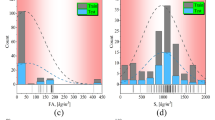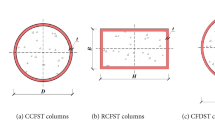Abstract
High-strength steel (HSS) columns are widely used in industry and construction because of their outstanding properties. Predicting the ultimate bearing capacity of HSS columns is not an easy task due to many nonlinear factors such as geometry and material properties. In this paper, a Cluster and Search Stacking Algorithm (CSSA) model based on the cluster algorithm, search algorithm, and Stacking algorithm is proposed to predict the ultimate bearing capacity of HSS columns. Specifically, the clustering algorithm is used to cluster the base models, and the search algorithm is implemented to find the best combination of base models in the Stacking algorithm. Results show that the proposed CSSA model is more effective than base models optimized by the Bayesian Optimization algorithm. Furthermore, the Bland–Altman approach is utilized to examine the consistency of the CSSA model to validate its reliability. Finally, the Shapley additive explanation (SHAP) method is introduced to analyze and explain the ultimate bearing capacity predicted by the CSSA model.



















Similar content being viewed by others
References
Kuziak, R., Kawalla, R., Waengler, S.: Advanced high strength steels for automotive industry. Arch. Civ. Mech. Eng. 8(2), 103–117 (2008). https://doi.org/10.1016/S1644-9665(12)60197-6
Marino, E.M., Nakashima, M., Mosalam, K.M.: Comparison of European and Japanese seismic design of steel building structures. Eng. Struct. 27(6), 827–840 (2005). https://doi.org/10.1016/j.engstruct.2005.01.004
Miki, C., Homma, K., Tominaga, T.: High strength and high performance steels and their use in bridge structures. J. Constr. Steel. Res. 58(1), 3–20 (2002). https://doi.org/10.1016/S0143-974X(01)00028-1
Ministry Of, H., Urban-Rural Development of the People’s Republic Of, C.: Standard for Design of Steel structures (GB 50017-2017). China Architecture and Building Press Beijing, China (2017)
Standard, B.: Eurocode 3—Design of steel structures—. BS EN 1(2005), 1993–2001 (2006)
Aisc: ANSI/AISC 360‐16: specification for structural steel buildings. (2016)
Phillips, A., Liu, C.S., Justusson, J.W.: An experimental investigation of yield surfaces at elevated temperatures. Acta Mech. 14(2), 119–146 (1972). https://doi.org/10.1007/BF01184853
Shi, G., Xu, K., Ban, H., Lin, C.: Local buckling behavior of welded stub columns with normal and high strength steels. J. Constr. Steel. Res. 119, 144–153 (2016). https://doi.org/10.1016/j.jcsr.2015.12.020
Shi, G., Zhou, W., Lin, C.: Experimental investigation on the local buckling behavior of 960 MPa high strength steel welded section stub columns. Adv. Struct. Eng. 18(3), 423–437 (2015). https://doi.org/10.1260/1369-4332.18.3.423
Yang, L., Shi, G., Zhao, M., Zhou, W.: Research on interactive buckling behavior of welded steel box-section columns. Thin-Walled Struct. 115, 34–47 (2017). https://doi.org/10.1016/j.tws.2017.01.030
Beg, D., Hladnik, L.: Slenderness limit of Class 3 I cross-sections made of high strength steel. J. Constr. Steel. Res. 38(3), 201–217 (1996). https://doi.org/10.1016/0143-974X(96)00025-9
Wang, Y.-B., Li, G.-Q., Chen, S.-W., Sun, F.-F.: Experimental and numerical study on the behavior of axially compressed high strength steel box-columns. Eng. Struct. 58, 79–91 (2014). https://doi.org/10.1016/j.engstruct.2013.10.013
Cao, X., Zhao, G., Kong, Z., Shen, H., Cheng, C., Chen, Z., Kim, S.-E.: Experimental study on local buckling of 800 MPa HSS welded I-section columns under axial compression. Thin-Walled Struct. 155, 106878 (2020). https://doi.org/10.1016/j.tws.2020.106878
Kaveh, A., Dadras Eslamlou, A., Javadi, S.M., Geran Malek, N.: Machine learning regression approaches for predicting the ultimate buckling load of variable-stiffness composite cylinders. Acta Mech. 232(3), 921–931 (2021). https://doi.org/10.1007/s00707-020-02878-2
Abueidda, D.W., Koric, S., Sobh, N.A.: Topology optimization of 2D structures with nonlinearities using deep learning. Comput. Struct. 237, 106283 (2020). https://doi.org/10.1016/j.compstruc.2020.106283
Koeppe, A., Bamer, F., Markert, B.: An efficient Monte Carlo strategy for elasto-plastic structures based on recurrent neural networks. Acta Mech. 230(9), 3279–3293 (2019). https://doi.org/10.1007/s00707-019-02436-5
Sudarsana Rao, H., Ghorpade, V.G., Mukherjee, A.: A genetic algorithm based back propagation network for simulation of stress–strain response of ceramic-matrix-composites. Comput. Struct. 84(5), 330–339 (2006). https://doi.org/10.1016/j.compstruc.2005.09.022
Dai, Y., Roy, K., Fang, Z., Chen, B., Raftery, G.M., Lim, J.B.P.: A novel machine learning model to predict the moment capacity of cold-formed steel channel beams with edge-stiffened and un-stiffened web holes. J. Build. Eng. 53, 104592 (2022). https://doi.org/10.1016/j.jobe.2022.104592
Li, X.-Q., Song, L.-K., Bai, G.-C.: Recent advances in reliability analysis of aeroengine rotor system: a review. Int. J. Struct. Integrity 13(1), 1–29 (2022). https://doi.org/10.1108/IJSI-10-2021-0111
Fang, Z., Roy, K., Mares, J., Sham, C.-W., Chen, B., Lim, J.B.P.: Deep learning-based axial capacity prediction for cold-formed steel channel sections using Deep Belief Network. Structures 33, 2792–2802 (2021). https://doi.org/10.1016/j.istruc.2021.05.096
Degtyarev, V.V., Tsavdaridis, K.D.: Buckling and ultimate load prediction models for perforated steel beams using machine learning algorithms. J. Build. Eng. 51, 104316 (2022). https://doi.org/10.1016/j.jobe.2022.104316
Seung-Eock, K., Quang-Viet, V., George, P., Zhengyi, K., Viet-Hung, T.: Comparison of machine learning algorithms for regression and classification of ultimate load-carrying capacity of steel frames. Steel Compos. Struct. 37, 193–209 (2020). https://doi.org/10.12989/scs.2020.37.2.193
Dissanayake, M., Nguyen, H., Poologanathan, K., Perampalam, G., Upasiri, I., Rajanayagam, H., Suntharalingam, T.: Prediction of shear capacity of steel channel sections using machine learning algorithms. Thin-Walled Struct. 175, 109152 (2022). https://doi.org/10.1016/j.tws.2022.109152
Xiong, J., Zhang, T., Shi, S.: Machine learning of mechanical properties of steels. Sci. China Technol. Sci. 63(7), 1247–1255 (2020). https://doi.org/10.1007/s11431-020-1599-5
Cindy, N.N.K., Pang-Jo, C., Kazuaki, O.: Tensile strength prediction of corroded steel plates by using machine learning approach. Steel Compos. Struct. 24, 635–641 (2017). https://doi.org/10.12989/scs.2017.24.5.635
Gao, J., Wang, C., Xu, Z., Wang, J., Yan, S., Wang, Z.: Gaussian process regression based remaining fatigue life prediction for metallic materials under two-step loading. Int. J. Fatigue 158, 106730 (2022). https://doi.org/10.1016/j.ijfatigue.2022.106730
He, L., Wang, Z., Akebono, H., Sugeta, A.: Machine learning-based predictions of fatigue life and fatigue limit for steels. J. Mater. Sci. Technol. 90, 9–19 (2021). https://doi.org/10.1016/j.jmst.2021.02.021
Pala, M., Caglar, N.: A parametric study for distortional buckling stress on cold-formed steel using a neural network. J. Constr. Steel. Res. 63(5), 686–691 (2007). https://doi.org/10.1016/j.jcsr.2006.07.005
Cao, X., Liu, S., Cheng, C., Zhong, R., Tao, Z., Zhou, X., Kong, Z.: Numerical simulation for local buckling behaviour of HSS welded I-section columns under axial compression. Thin-Walled Struct. 174, 109060 (2022). https://doi.org/10.1016/j.tws.2022.109060
Dai, H., Macbeth, C.: Effects of Learning Parameters on Learning Procedure and Performance of a BPNN. Neural Netw. 10(8), 1505–1521 (1997). https://doi.org/10.1016/S0893-6080(97)00014-2
Friedman, J.H.: Greedy function approximation: a gradient boosting machine. Ann. Stat. (2001). https://doi.org/10.1214/aos/1013203451
Pelikan, M., Goldberg, D.E., Cantú-Paz, E.: BOA: the Bayesian optimization algorithm. In: Proceedings of the 1st Annual Conference on Genetic and Evolutionary Computation—Volume 1, pp. 525–532. Morgan Kaufmann Publishers Inc., Orlando (1999)
Snoek, J., Larochelle, H., Adams, R.P.: Practical bayesian optimization of machine learning algorithms. In: Advances in Neural Information Processing Systems 25 (2012). arXiv:1206.2944
Victoria, A.H., Maragatham, G.: Automatic tuning of hyperparameters using Bayesian optimization. Evol. Syst. 12(1), 217–223 (2021). https://doi.org/10.1007/s12530-020-09345-2
Wu, J., Chen, X.-Y., Zhang, H., Xiong, L.-D., Lei, H., Deng, S.-H.: Hyperparameter optimization for machine learning models based on Bayesian optimization b. J. Electron. Sci. Technol. 17(1), 26–40 (2019). https://doi.org/10.11989/JEST.1674-862X.80904120
Wolpert, D.H.: Stacked generalization. Neural Netw. 5(2), 241–259 (1992). https://doi.org/10.1016/S0893-6080(05)80023-1
Wang, M., Wang, H., Wang, J., Liu, H., Lu, R., Duan, T., Gong, X., Feng, S., Liu, Y., Cui, Z., Li, C., Ma, J.: A novel model for malaria prediction based on ensemble algorithms. PLoS ONE (2019). https://doi.org/10.1371/journal.pone.0226910
Cui, S., Yin, Y., Wang, D., Li, Z., Wang, Y.: A stacking-based ensemble learning method for earthquake casualty prediction. Appl. Soft. Comput 101, 107038 (2021). https://doi.org/10.1016/j.asoc.2020.107038
Jiang, M., Liu, J., Zhang, L., Liu, C.: An improved Stacking framework for stock index prediction by leveraging tree-based ensemble models and deep learning algorithms. Physica A 541, 122272 (2020). https://doi.org/10.1016/j.physa.2019.122272
Chicco, D., Warrens, M.J., Jurman, G.: The coefficient of determination R-squared is more informative than SMAPE, MAE, MAPE, MSE and RMSE in regression analysis evaluation. PeerJ Comput. Sci. 7, e623 (2021). https://doi.org/10.7717/peerj-cs.623
Singh, A., Yadav, A., Rana, A.: K-means with three different distance metrics. Int. J. Comput. Appl. (2013). https://doi.org/10.5120/11430-6785
Li, W., Xing, X., Liu, F., Zhang, Y.: Application of improved grid search algorithm on SVM for classification of tumor gene. Int. J. Multimedia Ubiquit. Eng. 9(11), 181–188 (2014). https://doi.org/10.14257/ijmue.2014.9.11.18
Urolagin, S., Sharma, N., Datta, T.K.: A combined architecture of multivariate LSTM with Mahalanobis and Z-Score transformations for oil price forecasting. Energy 231, 120963 (2021). https://doi.org/10.1016/j.energy.2021.120963
Dabiri, H., Kheyroddin, A., Faramarzi, A.: Predicting tensile strength of spliced and non-spliced steel bars using machine learning- and regression-based methods. Constr. Build. Mater. 325, 126835 (2022). https://doi.org/10.1016/j.conbuildmat.2022.126835
Azimi, H., Bonakdari, H., Ebtehaj, I., Gharabaghi, B., Khoshbin, F.: Evolutionary design of generalized group method of data handling-type neural network for estimating the hydraulic jump roller length. Acta Mech. 229(3), 1197–1214 (2018). https://doi.org/10.1007/s00707-017-2043-9
Martin Bland, J., Altman, D.: Statistical methods for assessing agreement between two methods of clinical measurement. Lancet 327(8476), 307–310 (1986). https://doi.org/10.1016/S0140-6736(86)90837-8
Lipton, Z.C.: The mythos of model interpretability: In machine learning, the concept of interpretability is both important and slippery. Queue 16(3), 31–57 (2018)
Lundberg, S.M., Lee, S.-I.: A unified approach to interpreting model predictions. In: Advances in Neural Information Processing Systems 30 (2017). arXiv:1705.07874
Štrumbelj, E., Kononenko, I.: Explaining prediction models and individual predictions with feature contributions. Knowl. Inf. Syst. 41(3), 647–665 (2014). https://doi.org/10.1007/s10115-013-0679-x
Acknowledgements
The project is supported by the National key research and development program (Grant No. 2020YFA0710904-03), National Natural Science Foundation of China (Grant No. U20A20285 and NO. 52172357), Science Foundation of Hunan Province (Grant No. 2021JJ10016) and Key Research and Development Program of Hunan Province (Grant No. 2020GK4062 and 2020GK2094). This work was also supported by Leverhulme Trust Research Fellowship and National Science and Technology Ministry, PR China (Gant No. G2022160016L).
Author information
Authors and Affiliations
Corresponding author
Additional information
Publisher's Note
Springer Nature remains neutral with regard to jurisdictional claims in published maps and institutional affiliations.
Rights and permissions
Springer Nature or its licensor (e.g. a society or other partner) holds exclusive rights to this article under a publishing agreement with the author(s) or other rightsholder(s); author self-archiving of the accepted manuscript version of this article is solely governed by the terms of such publishing agreement and applicable law.
About this article
Cite this article
He, Z.C., Peng, Y., Han, J. et al. A Cluster and Search Stacking Algorithm (CSSA) for predicting the ultimate bearing capacity of an HSS column. Acta Mech 234, 1627–1648 (2023). https://doi.org/10.1007/s00707-022-03446-6
Received:
Revised:
Accepted:
Published:
Issue Date:
DOI: https://doi.org/10.1007/s00707-022-03446-6




